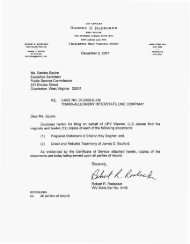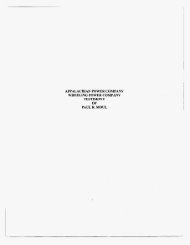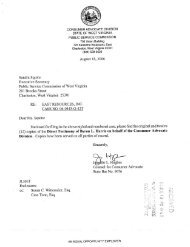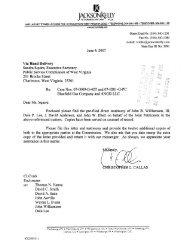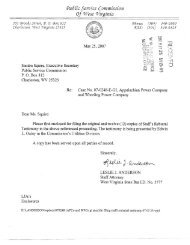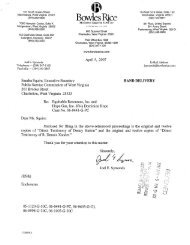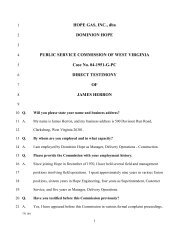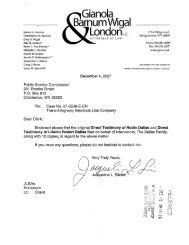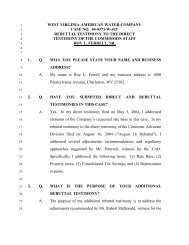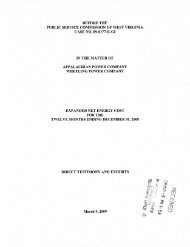Direct Testimony of Thomas M. Hildebrand - Consumer Advocate ...
Direct Testimony of Thomas M. Hildebrand - Consumer Advocate ...
Direct Testimony of Thomas M. Hildebrand - Consumer Advocate ...
Create successful ePaper yourself
Turn your PDF publications into a flip-book with our unique Google optimized e-Paper software.
,<br />
I ayc 3 UI i,<br />
we can get the greatest reduction for our limited financial resources. As with any<br />
pollution management program, the greatest clean-up gains per dollar spent are<br />
made from initial regulation. lust by implementing accountability standards and<br />
establishing management programs, great pollution reductions are achieved in<br />
the initial stages <strong>of</strong> poilution management, It is the later stages, generally those<br />
that are working to virtually eliminate pollution from a particular source, that are<br />
overwhelmingly costly. In the case <strong>of</strong> clean water, point source regulation has<br />
been ongoing since the 1972 CWA, but non-point regulation has been severely<br />
lacking and thus presents the greatest opportunity for pollution reduction,<br />
Investing in Clean Water<br />
A 2004 report by the Chesapeake Bay Commission identified six least-cost<br />
options to clean up the bay. Five <strong>of</strong> them focused on agriculture and non-point<br />
sources, indicating just how underdeveloped such programs are. The remaining<br />
suggestion is just what the Harrisonburg-Rockingham Sewer Authority is doing,<br />
upgrading its plant to the limit <strong>of</strong> present technology. They estimated that these<br />
six options, if implemented, could achieve 75% <strong>of</strong> the reduction goal for Nitrogen<br />
at the relatively low cost <strong>of</strong> $623 million total for all the bay states, but each<br />
come with their own individual cost. As seen in figure 2 below, while water<br />
treatment facility upgrades have great potential for reducing nitrogen loads, they<br />
are the most expensive reductions to achieve per pound,<br />
NITROGEN<br />
PHOSPHORUS<br />
SEDIMENT<br />
Measures M. Ibs. $/lb.<br />
Waste Treatment 35.0 8,56<br />
Upgrades<br />
Diet and Feed<br />
Changes<br />
Nutrient<br />
Management<br />
Enhanced Nutrient<br />
Mgmt.<br />
13.6 1.66<br />
23.7 4.41<br />
Conservation Tilage 12.0 1.57<br />
CoverCrops 23.3 3.13<br />
M. Ibs. $/lb. M. Ibs. $/lb.<br />
3.0 74.00 na<br />
0.22 0.00 na<br />
0.80 28.26 na<br />
0.80 95.79 na<br />
2.59 1.68<br />
0.44 0.22<br />
na=Not applicable - = No additional cos<br />
t<br />
Implications<br />
Total potential reductions for nonpoint<br />
sources (2-6) at the edge <strong>of</strong> the field*<br />
Totai potential reductions for nonpoint<br />
sources (2-6) delivered to the Bay**<br />
Total potential reductions for ail six<br />
practices (1-6) delivered to the Bay**<br />
Bay Agreement reduction goal (2002-<br />
2010)<br />
NITROGEN PHOSPHORUS SEDIMENT<br />
53.6m lbs. 2.93m Ibs. 1.35m tons<br />
45.4m Ibs. 1.99m Ibs. 0.90m tons<br />
80.4m lbs. 4.99m ibs. 0.90m tons<br />
103m ibs. 6.7m Ibs. 0.90m tons<br />
* The reductions attributed to each agricultural practice ae less when<br />
combinedwith outer practices on the same land. Therefore, the expected ttoal<br />
reduction from combing agricultural practices is less than their sum.<br />
** Agricultural reductions are measured at edge <strong>of</strong> field, and are reduced by<br />
the time they reach the bay; this results in totla reductions in loadings from<br />
those six practices as indicated. Waste treatment plant reductions estimates<br />
are as delivered to the bay.<br />
Figure 2: Nutrient reduction by cost. Source: Chesapeake Bay commission<br />
"Cost-Effective strategies for nutrient and sediment reduction" 2004<br />
Why then, did the state choose to promote this reduction above the others<br />
suggested in the report? Primarily, point source reductions are the most<br />
convenient to enforce, A monitoring structure is already in place for point source<br />
reduction, and there is great potential for reduction in this category. Additionally,



